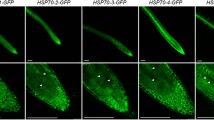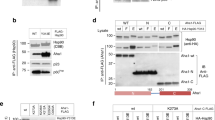Abstract
A Brassica napus cDNA encoding the 90 kDa heat shock protein, hsp90, was modified to add 6 histidines at the C-terminus and expressed in insect cells to prepare a recombinant histidine-tagged hsp90. The recombinant protein was purified over Ni2+-NTA agarose columns and its identity was confirmed by Western blotting, using a plant hsp90-specific antiserum. Incubation of purified hsp90 with [γ-32P] ATP in the presence of Mn2+ resulted in its autophosphorylation on serine residues. The purified hsp90 could also phosphorylate other protein substrates such as histones and casein in the presence of Mn2+. Analysis of phosphorylated casein revealed that serine residues are phosphorylated by hsp90. This is the first demonstration that a cytosolic hsp90 homolog can phosphorylate other protein substrates.
Similar content being viewed by others
References
Hendrick JP, Hartl F-U: Molecular chaperone functions of heat-shock proteins. Ann Rev Biochem 62: 349–384, 1993
Parsell DA, Lindquist S: The functions of heat-shock proteins in stress tolerance: Degradation and reactivation of damaged proteins. Ann Rev Genet 27: 437–496, 1993
Pratt WB: The role of heat shock proteins in regulating the function, folding, and trafficking of the glucocorticoid receptor. J Biol Chem 268: 21455–21458, 1993
Picard D, Khursheed B, Garabedian MJ, Fortin MG, Lindquist S, Yamamoto KR: Reduced levels of hsp90 compromise steroid receptor action in vivo. Nature 348: 166–168, 1990
Brugge JS: Interaction of the Rous sarcoma virus protein pp60src with the cellular proteins pp50 and pp90. Curr Top Microbiol Immunol 123: 1–22, 1986
Miyata Y, Yahara I: The 90-kDa heat shock protein, HSP90, binds and protects casein kinase II from self-aggregation and enhances its kinase activity. J Biol Chem 267: 7042–7047, 1992
Csermely P, Kahn CR: The 90-kDa heat shock protein (hsp90) possesses an ATP binding site and autophosphorylating activity. J Biol Chem 266: 4943–4950, 1991
Nadeau K, Das A, Walsh CT: Hsp90 chaperonins possess ATPase activity and bind heat shock transcription factors and peptidyl prolyl isomerases. J Biol Chem 268: 1479–1487, 1993
Csermely P, Kajtar J, Hollosi M, Jalsovszky G, Holly S, Kahn CR, Gergely P, Soti C, Mihaly K, Somogyi J: ATP induces a conformational change of the 90-kDa heat shock protein (hsp90). J Biol Chem 268: 1901–1907, 1993
Dechert U, Weber P, Konig B, Ortwein C, Nilson I, Linxweiler W, Wollny E, Gassen HG: A protein kinase isolated from porcine brain microvessels is similar to a class of heat-shock proteins. Eur J Biochem 225: 805–809, 1994
Szyszka R, Kramer G, Hardesty B: The phosphorylation state of the reticulocyte 90-kDa heat shock protein affects its ability to increase phosphorylation of peptide initiation factor 2 α subunit by the hemesensitive kinase. Biochemistry 28: 1435–1438, 1989
Conner TW, Lafayette PR, Nagao RT, Key JL: Sequence and expression of a HSP83 from Arabidopsis thaliana. Plant Physiol 94: 1689–1695, 1990
Koning AJ, Rose R, Comai L: Developmental expression of tomato heat-shock cognate protein 80. Plant Physiol 100: 801–811, 1992
Felsheim RF, Das A: Structure and expression of a heat-shock protein 83 gene of Pharbitis nil. Plant Physiol 100: 1764–1771, 1992
Marrs KAE, Casey ES, Capitant SA, Bouchard RA, Dietrich PS, Mettler IJ, Sinibaldi RM: Characterization of two maize hsp90 heat shock protein genes and expression during heat shock, embryogenesis, and pollen development. Dev Genet 14: 27–41, 1993
Krishna P, Sacco M, Cherutti JF, Hill S: Cold-induced accumulation of hsp90 transcripts in Brassica napus. Plant Physiol 107: 915–923, 1995
Li Y, Luo L, Thomas D, Kang CY: Control of expression, glycosylation, and secretion of HIV-1 gpl20 by homologous and heterologous signal sequences. Virology 204: 266–278, 1994
Kitts PA, Possee RD: A method for producing recombinant baculovirus expression vectors at high frequency. Biotechniques 14: 810–816, 1993
Laemmli UK: Cleavage of structural proteins during the assembly of the head of bacteriophage T4. Nature 227: 680–685, 1970
Krishna P, Reddy RK, Sacco M, Frappier JRH, Felsheim RF: Analysis of the native forms of the 90 kDa heat shock protein (hsp90) in plant cytosolic extracts. Plant Mol Biol 33: 457–466, 1997
Csermely P, Kajtar J, Hollosi M, Oikarinen J, Somogyi J: The 90 kDa heat shock protein (hsp90) induces the condensation of the chromatin structure. Biochem Biophys Res Commun 202: 1657–1663, 1994
Rose DW, Welch WJ, Kramer G, Hardesty B: Possible involvement of the 90-kDa heat shock protein in the regulation of protein synthesis. J Biol Chem 264: 6239–6244, 1989
Stancato LF, Chow Y-H, Hutchison KA Perdew GH, Jove R, Pratt WB: Raf exists in a native heterocomplex with hsp90 and p50 that can be reconstituted in a cell-free system. J Biol Chem 268: 21711–21716, 1993
Aligue R, Akhavan-Niak H, Russell P: A role for hsp90 in cell cycle control: Weel tyrosine kinase activity requires interaction with hsp90. EMBO J 13: 6099–6106, 1994
Cutforth T, Rubin GM: Mutations in hsp83 and cdc37 impair signaling by the sevenless receptor tyrosine kinase in Drosophila. Cell 77: 1027–1036, 1994
Stancato LF, Hutchison KA, Krishna P, Pratt WB: Animal and plant cell lysates share a conserved chaperone system that assembles the glucocorticoid receptor into a functional heterocomplex with hsp90. Biochemistry 35: 554–561, 1996
Dittmar KD, Demady DR, Stancato LF, Krishna P, Pratt WB: Folding of the glucocorticoid receptor by the hsp90-based chaperone machinery: The role of p23 is to dynamically stabilize receptor hsp90 heterocomplexes formed by hsp90·p60·hsp70. J Biol Chem 272: 21213–21220, 1997
Owens-Grillo JK, Stancato LF, Hoffmann K, Pratt WB, Krishna P: Binding of immunophilins to the 90 kDa heat shock protein (hsp90) via a tetratricopeptide repeat domain is a conserved protein interaction in plants. Biochemistry 35: 15249–15255, 1996
Author information
Authors and Affiliations
Rights and permissions
About this article
Cite this article
Park, M., Yong Kang, C. & Krishna, P. Brassica napus hsp90 can autophosphorylate and phosphorylate other protein substrates. Mol Cell Biochem 185, 33–38 (1998). https://doi.org/10.1023/A:1006884306169
Issue Date:
DOI: https://doi.org/10.1023/A:1006884306169




